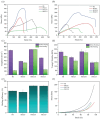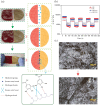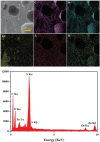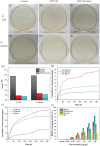Antibacterial, self-healing, and pH-responsive PVA/ZIF-8@tannic acid nanocomposite hydrogel for sustained delivery of garlic extract
- PMID: 40595265
- PMCID: PMC12217915
- DOI: 10.1038/s41598-025-07752-6
Antibacterial, self-healing, and pH-responsive PVA/ZIF-8@tannic acid nanocomposite hydrogel for sustained delivery of garlic extract
Abstract
Hydrogels are increasingly recognized in biological research due to their unique characteristics and broad potential applications. In this study, a pH-responsive hydrogel-based nanocomposite was designed with antibacterial activity and self-healing ability, highlighting its promising applications in biomedical engineering and materials science. The hydrogel-based nanocomposite consists of a polyvinyl alcohol (PVA) hydrogel crosslinked with borax (PB), zinc-based zeolitic imidazolate framework-8 nanoparticles modified with tannic acid (ZIF-8@TA), and garlic extract. The pH-responsiveness of the hydrogel arises from ZIF-8@TA and borax, which undergoes controlled degradation in acidic and basic conditions, enabling the targeted release of zinc ions beneficial for infected wounds. Its physicochemical and mechanical properties, self-healing abilities, and rheological behavior have been thoroughly investigated. The antimicrobial efficacy, antioxidant activity, biocompatibility, and release of zinc and sulfur ions were also evaluated. Mechanical analysis demonstrates tensile strengths ranging from 109 to 353 kPa, highlighting the material's versatility and suitability for applications such as wound dressings. Additionally, the hydrogels exhibited healing efficiencies ranging from 65.45 to 85.27% across samples with varying ZIF-8@TA concentrations (5-15 wt%). Antibacterial studies of hydrogels (0.5 g/mL) demonstrated 100% bacterial inhibition against Escherichia coli and Staphylococcus aureus strains, while significant antioxidant activity and sustained release of zinc and sulfur ions were observed over a 15-day period. These findings make the ZIF-8@TA-modified PVA hydrogel a promising candidate for advanced biomedical applications, addressing challenges in infection management, tissue regeneration, and adaptability to diverse wound environments.
Keywords: Antibacterial; Garlic extract; Hydrogel; PVA; Self-healing; ZIF-8.
© 2025. The Author(s).
Conflict of interest statement
Declarations. Competing interests: The authors declare no competing interests.
Figures











Similar articles
-
Study on the Application of Zeolitic Imidazolate Framework-8 Loaded With Artemisia Argyi Essential Oil in the Treatment of Bacterial Infected Wounds.J Biomed Mater Res A. 2025 Jun;113(6):e37937. doi: 10.1002/jbm.a.37937. J Biomed Mater Res A. 2025. PMID: 40448391
-
A dynamically crosslinked, self-adapting, injectable gelatin-chondroitin sulfate hydrogel with antibacterial and antioxidant properties for treatment of deep and irregular wounds.J Mater Chem B. 2025 Jun 25;13(25):7293-7310. doi: 10.1039/d4tb02537g. J Mater Chem B. 2025. PMID: 40365810
-
ROS/pH Dual-Responsive Hydrogel Dressings Loaded with Amphiphilic Structured Nano Micelles for the Repair of Infected Wounds.Int J Nanomedicine. 2025 Jun 23;20:8119-8142. doi: 10.2147/IJN.S522589. eCollection 2025. Int J Nanomedicine. 2025. PMID: 40584783 Free PMC article.
-
Emerging role and potential of lignin in antibacterial hydrogel applications for wound healing: A review.Int J Biol Macromol. 2025 Jul;318(Pt 3):144976. doi: 10.1016/j.ijbiomac.2025.144976. Epub 2025 Jun 6. Int J Biol Macromol. 2025. PMID: 40484075 Review.
-
Hydrogel dressings for venous leg ulcers.Cochrane Database Syst Rev. 2022 Aug 5;8(8):CD010738. doi: 10.1002/14651858.CD010738.pub2. Cochrane Database Syst Rev. 2022. PMID: 35930364 Free PMC article.
Cited by
-
Exo-hydrogel therapy: a revolutionary approach to managing diabetic complications.J Nanobiotechnology. 2025 Aug 11;23(1):558. doi: 10.1186/s12951-025-03621-6. J Nanobiotechnology. 2025. PMID: 40790200 Free PMC article. Review.
References
-
- Gong, W. et al. Construction of double network hydrogels using agarose and gallic acid with antibacterial and anti-inflammatory properties for wound healing. Int. J. Biol. Macromol.227, 698–710 (2023). - PubMed
-
- He, J., Shi, M., Liang, Y. & Guo, B. Conductive adhesive self-healing nanocomposite hydrogel wound dressing for photothermal therapy of infected full-thickness skin wounds. Chem. Eng. J.394, 124888 (2020).
-
- Wang, L., Zhou, M., Xu, T. & Zhang, X. Multifunctional hydrogel as wound dressing for intelligent wound monitoring. Chem. Eng. J.433, 134625 (2022).
-
- Ding, S. et al. Photopolymerizable, immunomodulatory hydrogels of gelatin methacryloyl and carboxymethyl chitosan as all-in-one strategic dressing for wound healing. Int. J. Biol. Macromol.253, 127151 (2023). - PubMed
MeSH terms
Substances
LinkOut - more resources
Full Text Sources
Medical
Miscellaneous

